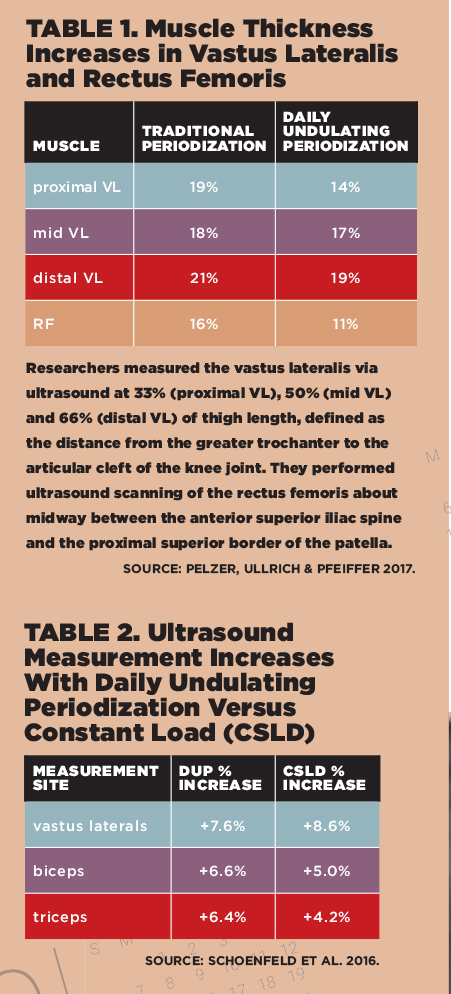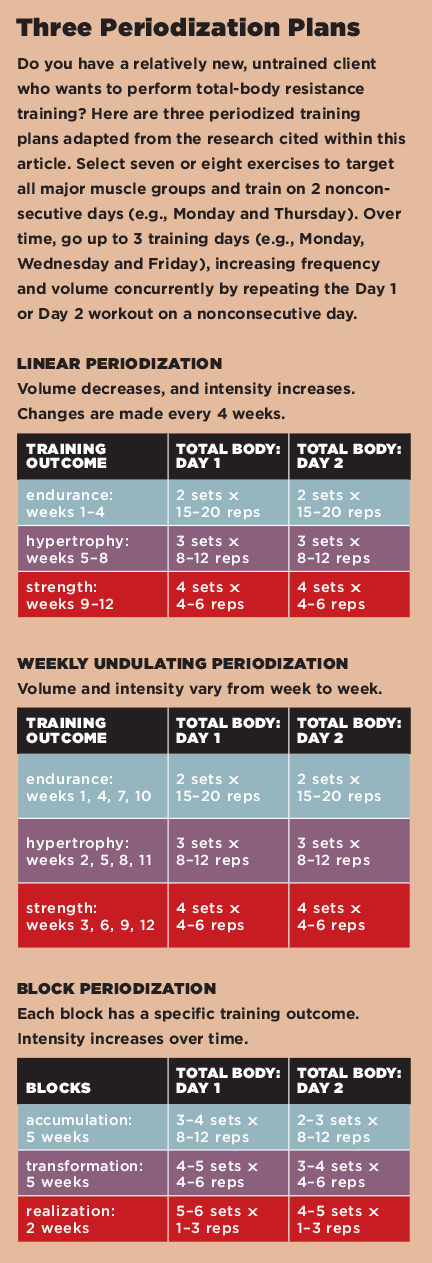Periodization for Maximizing Hypertrophy
Should you periodize your clients’ resistance training programs?
| Earn 1 CEC - Take Quiz

Much of the periodization literature to date has centered on the strength outcomes and sports performance of athletes striving to balance the needs of practice, conditioning and competition (Bartolomei et al. 2014). But many recreationally active clients seek to gain muscle size in personal training sessions, and few studies have evaluated whether a periodization model should be used in a hypertrophy-focused resistance training program for these fitness enthusiasts. This article highlights the best research available to help answer an important question: Should you periodize a client’s RT plan to maximize skeletal muscle hypertrophy?
Some Quick Definitions
Resistance training programs consist of numerous variables, including volume, intensity, frequency, rest intervals, exercise selection and exercise order (Williams et al. 2017). Periodization is defined as a planned, cyclical (i.e., the program repeats) manipulation of these RT variables to attain peak performance at specific times of the year (Evans 2019). Periodized RT plans comprise several cycles:
- a macrocycle (6–12 months);
- mesocycles (~1 month); and
- microcycles (~1 week) (Evans 2019; Issurin 2010).
The length of each training cycle in sports will vary, depending on the competition schedule and the athlete’s goals. Evans cites research denoting that lengthy periods of training devoid of variation will result in stagnation and fatigue. Thus, a major purpose of periodization is to provide structured variability to combat a plateau or decline in physical performance.
Types of Periodization
Researchers have focused their investigations primarily on three types of commonly employed periodization types: linear periodization, block periodization and undulating periodization:
Linear Periodization
Linear periodization (LP) is a training strategy that starts with high volume and low intensity and then progresses to low volume and high intensity (Grgic et al. 2017). LP was introduced in the late 1950s by Russian professor Lev Matveev and is also referred to as traditional periodization (TP) in the literature (Kok, Hamer & Bishop 2009; Bartolomei et al. 2014). With LP, exercisers gradually increase the intensity of load as the program progresses while simultaneously decreasing the volume (see Figure 1).
Theoretically, the initial high-volume phase emphasizes hypertrophic adaptations, and the later high-intensity period challenges the neural mechanisms in the body (Kok, Hamer & Bishop 2009). Note in Figure 1 how training technique specificity increases in parallel with training intensity in the LP model. Certainly, LP program designs vary among personal trainers, but it’s common to make changes to volume and intensity every 4 weeks (Grgic et al. 2017).
Block Periodization
Block periodization (BP) is made up of several mesocycles, each with a concentrated training stimulus for a specific aspect of performance (Bartolomei et al. 2014) (see Figure 2). Each mesocycle—or block of time—prepares clients for the next cycle. For sport applications, mesocycles are arranged into three categories: accumulation, transformation and realization (Issurin 2010). The BP training methodology was introduced in the mid-1980s by Russian scientist Yuri Verchosanskij to meet the changing needs of athletes (Bartolomei et al. 2014).
Conventionally, the accumulation block focuses primarily on general aerobic endurance, basic muscle strength and foundational movement techniques (Issurin 2010). During the transformation block, the athlete performs specialized muscle-conditioning exercises and practices sport-specific techniques (Issurin 2010). Last, the realization block is a pre-competition training phase focusing on attaining maximal speed and performance. Each block lasts 2–4 weeks, depending on the program duration and the client’s specific goals (Issurin 2010).
Undulating Periodization
Undulating periodization (UP) involves frequent alterations of volume and intensity within a training program; these alterations often occur weekly (WUP) and/or daily (DUP) (Evans 2019) (see Figures 3 and 4 for daily and weekly undulating periodization models). During a WUP program, exercisers cycle through weeks of light-, moderate- and high-intensity training. During DUP, these intensities vary from day to day. Practically speaking, a client in a DUP program may do a hypertrophy workout, a strength workout and a power workout within 1 week.
Evans summarizes research indicating that UP programs are likely the best choice for developing strength in RT programs. McNamara & Stearne (2010) submit that undulating programs are also advantageous because the design helps to prevent overtraining and mental boredom while also being easily adaptable to a client’s travel schedule. The frequent changes of volume and intensity in UP programs may induce larger neural adaptations, while concomitantly counteracting fatigue (Pelzer, Ullrich & Pfeiffer 2017). The term undulating refers to the “wave form” representation of intensities when graphed.
Unique Advantages of Periodized Resistance Training
- Lifting within the same intensity zone over time may lead to stagnation in results (Turner 2011). A periodized program prevents stagnation by continually overloading the neuromuscular system with varying intensities.
- Continual training with primarily heavy loads may lead to undue fatigue, overtraining and soft-tissue injury (Turner 2011; Williams et al. 2017). Periodized plans undulate through periods of low, moderate and high volume and intensity to prevent overtraining and performance decrements.
- In accordance with the S.A.I.D principle (specific adaptations to imposed demands), periodized plans allow personal trainers and their clients to program for a variety of specific training outcomes.
- Brand-new research demonstrates that low-intensity RT (30% of 1-RM) improves the quality and quantity of mitochondria (i.e., the ATP production organelles of cells) (Lim et al. 2019). Thus, intentionally including blocks of low intensity will also improve the aerobic capacity of skeletal muscle fibers.
- Periodized programs easily allow personal trainers to program low-volume tapering and de-loading
weeks to promote recovery and allow for neuromuscular adaptations (Turner 2011). - Periodization plans let personal trainers plan for phases of overreaching (brief microcycles in which volume and/or intensity are ramped up to deliver a strong stimulus for adaptation).
Periodization and Hypertrophy: Research Highlights
Two periodization studies over the past few years have targeted muscle hypertrophy as an outcome. One study focused on moderately resistance-trained women and the other on highly resistance-trained men. Here are reviews of both:
Moderately Resistance-Trained Women
Pelzer, Ullrich & Pfeiffer (2017) conducted very interesting research with 19 female college-aged students, none of whom were competitive athletes. The women had moderate experience in resistance training (averaging approximately 28 months). Volunteers had each of their legs randomly assigned to one of two conditions: daily undulating periodization or traditional periodization (aka linear periodization, as you’ll recall). Participants acted as their own controls because both legs were exercised and yet each was assigned a different periodization model. All volunteers trained 3 days per week for 6 weeks, for a total of 18 sessions, and the only exercise used was a single-leg knee extension.
The DUP leg varied daily among 40%, 60% and 80% of 1-RM, and the TP leg exercised for 2 weeks at each intensity, steadily increasing from 40% to 60% to 80% of 1-RM. Range of motion, volume and time under tension were identical between conditions. Participants completed all sets with one leg before switching to the other leg. There was a 2.5-minute rest between sets.
Ultrasound measurements revealed that both groups significantly increased their vastus lateralis and rectus femoris thickness (see Table 1) from pre- to posttest. There was no statistically significant difference in muscle thickness between groups (though thickness was slightly greater with TP).
Based on this research, if personal trainers are squeezed for time and a client wants to see results quickly (e.g., in 4–6 weeks), DUP and TP are both viable options for delivering a strong hypertrophic stimulus in moderately trained women.
Highly Resistance-Trained Men
Schoenfeld and associates (2016) divided highly resistance-trained college-aged males into two pair-matched groups based on their squat strength: a constant load (CSLD) group (n = 9) and a daily undulating periodization group (n = 10). The CSLD group performed moderate-intensity RT (8–12 repetitions) every time they lifted, while the DUP group performed heavy (2–4 reps), moderate (8–12 reps) and light (20–30 reps) RT on training days.
Both groups trained on 3 nonconsecutive days of the week for 8 weeks. All participants were encouraged to perform each set of exercises to the point of momentary failure, defined as an inability to complete the movement’s concentric phase. Rest time between sets was 2 minutes. Seven total-body exercises were performed on each day of lifting: bench press, military press, latissimus pulldown, seated row, back squat, leg press and knee extension. Muscle thickness was measured via ultrasound for the biceps, triceps and vastus lateralis at baseline and after 8 weeks of RT (see Table 2).
Both groups significantly improved muscle thickness, and there was no statistical difference in results between the two protocols. When examining the statistical magnitude of pre- to posttest change, referred to as the effect size, the research team found that DUP produced a more substantial improvement than CSLD in the biceps and triceps. This suggests that the DUP magnitude of difference for the biceps and triceps is noteworthy. In summary, the study findings indicate that 8 weeks of either DUP or CSLD training can significantly improve muscular adaptations in trained young men.
Overcoming the Biggest Limitation in Periodization Science
The biggest limitation in the periodization science is the short length of studies. Fortunately, there is a 9-month study conducted by Kraemer and associates (2003) for us to review.
The researchers divided 30 female collegiate tennis players into three groups: daily undulating periodization, constant load training and a control group (CON). Subjects assigned to DUP and CSLD performed total-body RT 3 days a week for 36 weeks, for a total of 108 sessions, while the CON group did not participate in any RT. With volume (sets x reps) equated, the DUP group rotated through three loading zones (4–6 reps, 8–10 reps and 12–15 reps), while the CSLD group performed RT at the same loading zone (8–10 reps) for the entire study. Of note, for both experimental groups, when a participant was capable of performing the required number of repetitions for three consecutive sets of a particular exercise, the training load was increased in increments of about 2–13 kilograms.
Compared with control participants, the two RT groups significantly increased their muscle mass (i.e., fat-free mass) (DUP = +7.1%; CSLD = +3.5%) and decreased their body fat (DUP = -16.6%; CSLD = -8.9%); more favorable results occurred in the DUP group, though there was no statistical difference between DUP and CSLD. To ensure long-term (e.g., 9- to 12-month) muscle adaptations, personal trainers are encouraged to periodize times of light, moderate and heavy lifting (see Figure 5) in their female clients’ training plans, as the DUP program in this study showed distinctively impressive results in many physiological parameters. DUP may also promote recovery between workouts, target multiple energy systems and limit the psychological burnout associated with performing the same routine every day.
Introducing Flexible Periodization: A New Periodization Approach

Flexible undulating periodization allows you to adapt a program to a client’s immediate health, nutrition or energy-level circumstance.
As every personal trainer knows, life brings unexpected twists that can cause clients undue stress, potentially interfering with their ability to perform at their optimal level. Smaller setbacks can be disruptive, too: A poor night of sleep, less than formidable pre-exercise nutrition or one skipped meal may leave a client feeling fatigued and unmotivated, even before the training session begins. In these situations, it may be best to modify the workout of the day to accommodate your client’s energy level and mood. You can do this by employing flexible undulating periodization.
Flexible undulating periodization (FUP) is a transient strategy for adapting a periodization program to a client’s immediate health, nutrition or energy-level circumstance. In a 12-week training study by McNamara and Stearne (2010), researchers randomly assigned 16 untrained resistance participants (ages 18–23; males, n = 12; females, n = 4) to a FUP resistance training group (n = 8) or an undulating periodization training group (n = 8). Twice-weekly 30-minute workouts combined free-weight and machine exercises. Both groups completed the same training volume using three intensity loads: 10-RM, 15-RM and 20-RM. However, the FUP group was given the freedom to choose which days they would perform the 10-RM, 15-RM and 20-RM loads of the various upper-body and lower-body exercises. Researchers took pre- and posttest measurements for the chest press, leg press and standing long jump.
Compared with the volume-matched undulating group, FUP participants showed similar improvements in the chest press and standing long jump. In the leg press, however, FUP participants saw a much greater strength increase (+62 kilograms) than the UP group (+16 kg).
McNamara and Stearne submit that flexible undulating periodization is a highly personalized program that adjusts workload to correspond with a client’s workout energy level or demeanor. Fitness professionals can easily employ FUP by simply assessing the present state of their client immediately before the training session and adjusting the workout accordingly. Ultimately, a FUP approach accounts for a client’s daily fluctuations in fatigue and psychological readiness. Logically, FUP may also increase exercise adherence by providing the client with autonomy and the freedom to direct training sessions based on his or her physiological status and/or mental demeanor.
Helpful Strategies to Add Variety to a Resistance Training Program
Vary the intensity. Research has shown that incorporating a variety of training intensities, such as light (20- to 30-RM), moderate (8- to 12-RM) and high (2- to 4-RM), effectively elicits hypertrophy (Schoenfeld et al. 2016), empowering you to use a blend of loading zones to add variety and keep your clients engaged.
Change the volume. Evidence suggests that low-, moderate- and high-volume RT are all effective for muscle growth (Schoenfeld et al. 2019).
Use tapering and/or overreaching. For a stimulus change, you may want to periodically implement microcycles with “tapering” (brief, but meaningful reductions in volume and/or intensity) and/or “overreaching” (concise but significant increases in volume and/or intensity) (Turner 2011).
Change the frequency. Recently, researchers concluded that targeting each muscle group 2 days a week is an optimal plan for hypertrophy in trained individuals (Grgic, Schoenfeld & Latella 2018). However, increasing frequency to 3 days a week in a periodic cycle is a viable strategy for inciting a training overload for a client.
Try reciprocal supersets. With supersets, you select exercises that target agonist and antagonist (e.g., biceps and triceps) or opposite-action (e.g., horizontal flexors and horizontal extensors) muscle groups; your clients will perform the exercises in succession before taking a rest interval (Kelleher et al. 2010). Use this style of program to decrease training time and deliver a stronger metabolic stress stimulus. You can try several push-pull combinations, including bench press + seated row, push press + latissimus dorsi pulldown, and back squat + hamstring curl.
Perform drop sets. In this protocol, load is commonly reduced by 20%–25% with each drop set, allowing minimal rest before starting the next set. It’s typical to employ 1–3 drop sets, taking 1–3 seconds on the concentric and eccentric actions (Schoenfeld & Grgic 2017).
Conclusion
Periodized resistance training delivers many essential physiological and mental health benefits (see Figure 6). Several studies indicate that linear periodization, undulating periodization and block periodization are all effective for attaining hypertrophy goals. You may want to consider employing each of these periodization types (as well as flexible undulating periodization) during the year to provide variety for your clients. Importantly, whichever periodization model you choose, the research provides a steadfast finding that optimal muscle and neural adaptations over the long run occur when the physiological training stress changes regularly. So be creative and, yes, definitely periodize!
References
Bartolomei, S., et al. 2014. A comparison of traditional and block periodized strength training programs in trained athletes. Journal of Strength and Conditioning Research, 28 (4), 990–97.
Evans, J.W. 2019. Periodized resistance training for enhancing skeletal muscle hypertrophy and strength: A mini-review. Frontiers in Physiology, 10 (13), 1–7.
Grgic, J., & Schoenfeld, B.J. 2018. Are the hypertrophic adaptations to high and low-load resistance training muscle fiber type specific? Frontiers in Physiology, 9 (42), 1–6.
Grgic, J., Schoenfeld, B.J., & Latella, C. 2018. Resistance training frequency and skeletal muscle hypertrophy: A review of available evidence. Journal of Science and Medicine in Sport, 22 (3), 361–70.
Grgic, J., et al. 2017. Effects of linear and daily undulating periodized resistance training programs on measure of muscle hypertrophy: A systematic review and meta-analysis. PeerJ, 5:e3695: doi:10.7717/peerj.3695.
Issurin, V.B. 2010. New horizons for the methodology and physiology of training periodization. Sports Medicine, 40 (3), 189–206.
Kelleher, A.R., et al. 2010. The metabolic costs of reciprocal supersets vs. traditional resistance exercise in young recreationally active adults. Journal of Strength and Conditioning Research, 24 (4), 1043–51.
Kok, L.Y., Hamer, P.W., & Bishop, D.J. 2009. Enhancing muscular qualities in untrained women: Linear versus undulated periodization. Medicine & Science in Sports & Exercise, 41 (9), 1797–1807.
Kraemer, W.J., et al. 2003. Physiological changes with periodized resistance training in women tennis players. Medicine & Science in Sports & Exercise, 35 (1), 157–68.
Lim, C., et al. 2019. Resistance exercise-induced changes in muscle metabolism are load-dependent. Medicine & Science in Sports & Exercise, 51 (12), 2578–85.
McNamara, J.M., & Stearne, D.J. 2010. Flexible nonlinear periodization in a beginner college weight training class. Journal of Strength and Conditioning Research, 24 (8), 2012–17.
Pelzer, T., Ullrich, B., & Pfeiffer, M. 2017. Periodization effects during short-term resistance training with equated exercise variables in females. European Journal of Applied Physiology, 117, 441–54.
Schoenfeld, B.J., & Grgic, J. 2017. Can drop set training enhance muscle growth? Strength and Conditioning Journal, 40 (6), 95–98.
Schoenfeld, B.J., et al. 2016. Effects of varied versus constant loading zones on muscular adaptations in trained men. International Journal of Sports Medicine, 37 (6), 442–7.
Schoenfeld, B.J., et al. 2019. Resistance training volume enhances muscle hypertrophy but not strength in trained men. Medicine & Science in Sports & Exercise, 51 (1), 94–103.
Turner, A. 2011. The science and practice of periodization: A brief review. Strength and Conditioning Journal, 33 (1), 34–46.
Williams, T.D., et al. 2017. Comparison of periodized and non-periodized resistance training on maximal strength: A meta-analysis. Sports Medicine, 47 (10), 2083–2100.
Len Kravitz, PhD
Len Kravitz, PhD is a professor and program coordinator of exercise science at the University of New Mexico where he recently received the Presidential Award of Distinction and the Outstanding Teacher of the Year award. In addition to being a 2016 inductee into the National Fitness Hall of Fame, Dr. Kravitz was awarded the Fitness Educator of the Year by the American Council on Exercise. Just recently, ACSM honored him with writing the 'Paper of the Year' for the ACSM Health and Fitness Journal.
Zachary Mang, PhD
Zachary Mang, PhD, is a postdoctoral research associate for the wellness program at the Los Alamos National Lab where he specializes in strength and conditioning for structural firefighters. His research interests include resistance training for hypertrophy, oxidative adaptations to resistance training, and the use of resistance training as a frontline defense to prevent chronic disease.















